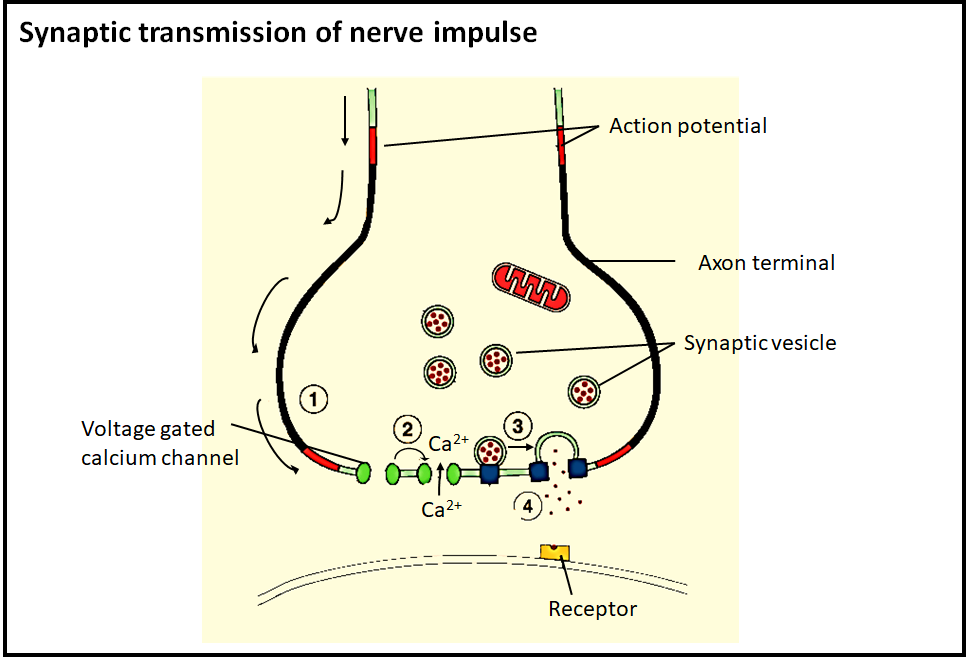
What happens at the synapse between two neurons:
(a)Synaptic transmission of stimulus
(b)The signals will be diminished
(c)Jumping of the stimulus from one synapse to another
(d)Generation of an electric signal
Answer
576.9k+ views
Hint: Synapse is the functional area of contact between the two neurons. The nerve impulse or the stimulus flows from the axon terminal of one neuron to the dendrites of another neuron.
Complete answer:
Synaptic transmission of stimulus takes place at the synapse between two neurons. A nerve impulse flows from one neuron to another through the synapse. The first neuron in this pathway is known as a presynaptic neuron and the second neuron in this pathway is known as a postsynaptic neuron. The space between them is called the synaptic cleft. A stimulus must be transmitted through the synapse to enter a fresh wave of a nerve impulse.
Additional Information:
Synapse is of two types - Electrical synapses and Chemical Synapses. In electrical synapses, the membranes of the pre- and postsynaptic neurons are extremely close to one another which makes the transmission of impulse across the electrical synapse very similar to that of a single axon. The continuity is provided by gap junctions between the two neurons. These are small protein tubular structures that allow free movement of ions across the synapse as conduction of an impulse involves the flow of ions across the membranes of neurons.
In a chemical synapse, the pre- and postsynaptic neurons are separated by synaptic cleft, a fluid-filled space. Axon terminals include vesicles saturated with neurotransmitters. An impulse after reaching the nerve ending or axon terminals stimulates the fusion of these vesicles with the presynaptic membranes and the content of the vesicles i.e neurotransmitters are released in the synaptic fluid. The released neurotransmitters bind to their unique receptors at the dendritic membranes of postsynaptic neurons and lead to the opening of ion channels. The entry of ions causes a fresh wave of a nerve impulse down this neuron.
So, the correct answer is ‘Synaptic transmission of the stimulus’.
Note: Acetylcholine, norepinephrine, and Gamma amino-butyric acid (GABA), dopamine are some examples of neurotransmitters. Once they are released in the synaptic cleft and have changed the permeability of postsynaptic neurons, the neurotransmitters need to be immediately lost from the synaptic cleft. This task is performed by certain enzymes present in high concentration in the synapse. They break down the neurotransmitter in products that need to be reabsorbed by a presynaptic neuron and used for its resynthesis.

Complete answer:
Synaptic transmission of stimulus takes place at the synapse between two neurons. A nerve impulse flows from one neuron to another through the synapse. The first neuron in this pathway is known as a presynaptic neuron and the second neuron in this pathway is known as a postsynaptic neuron. The space between them is called the synaptic cleft. A stimulus must be transmitted through the synapse to enter a fresh wave of a nerve impulse.
Additional Information:
Synapse is of two types - Electrical synapses and Chemical Synapses. In electrical synapses, the membranes of the pre- and postsynaptic neurons are extremely close to one another which makes the transmission of impulse across the electrical synapse very similar to that of a single axon. The continuity is provided by gap junctions between the two neurons. These are small protein tubular structures that allow free movement of ions across the synapse as conduction of an impulse involves the flow of ions across the membranes of neurons.
In a chemical synapse, the pre- and postsynaptic neurons are separated by synaptic cleft, a fluid-filled space. Axon terminals include vesicles saturated with neurotransmitters. An impulse after reaching the nerve ending or axon terminals stimulates the fusion of these vesicles with the presynaptic membranes and the content of the vesicles i.e neurotransmitters are released in the synaptic fluid. The released neurotransmitters bind to their unique receptors at the dendritic membranes of postsynaptic neurons and lead to the opening of ion channels. The entry of ions causes a fresh wave of a nerve impulse down this neuron.
So, the correct answer is ‘Synaptic transmission of the stimulus’.
Note: Acetylcholine, norepinephrine, and Gamma amino-butyric acid (GABA), dopamine are some examples of neurotransmitters. Once they are released in the synaptic cleft and have changed the permeability of postsynaptic neurons, the neurotransmitters need to be immediately lost from the synaptic cleft. This task is performed by certain enzymes present in high concentration in the synapse. They break down the neurotransmitter in products that need to be reabsorbed by a presynaptic neuron and used for its resynthesis.

Recently Updated Pages
Master Class 12 Business Studies: Engaging Questions & Answers for Success

Master Class 12 Economics: Engaging Questions & Answers for Success

Master Class 12 English: Engaging Questions & Answers for Success

Master Class 12 Maths: Engaging Questions & Answers for Success

Master Class 12 Social Science: Engaging Questions & Answers for Success

Master Class 12 Chemistry: Engaging Questions & Answers for Success

Trending doubts
What is meant by exothermic and endothermic reactions class 11 chemistry CBSE

Which animal has three hearts class 11 biology CBSE

10 examples of friction in our daily life

One Metric ton is equal to kg A 10000 B 1000 C 100 class 11 physics CBSE

1 Quintal is equal to a 110 kg b 10 kg c 100kg d 1000 class 11 physics CBSE

Difference Between Prokaryotic Cells and Eukaryotic Cells




